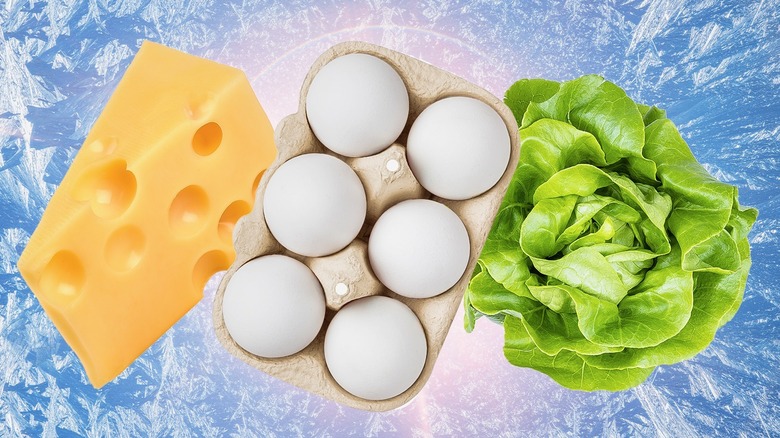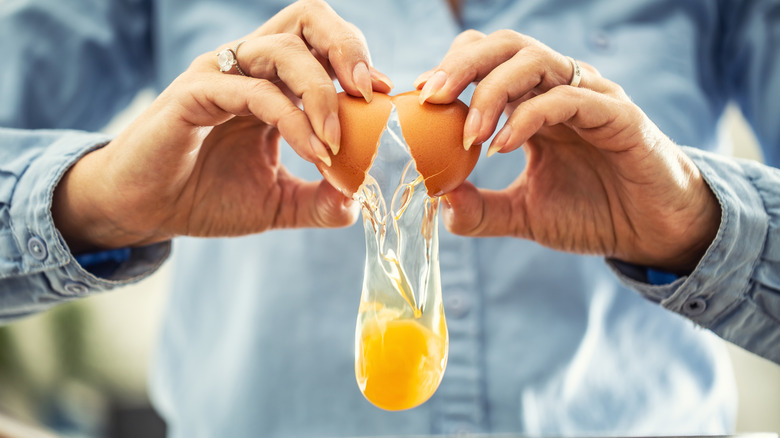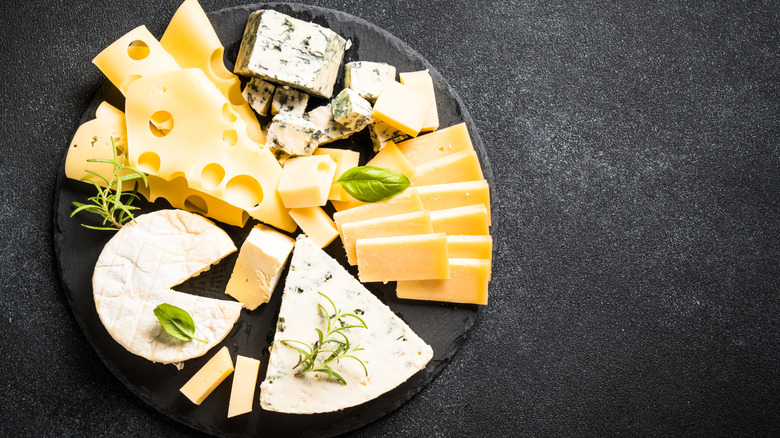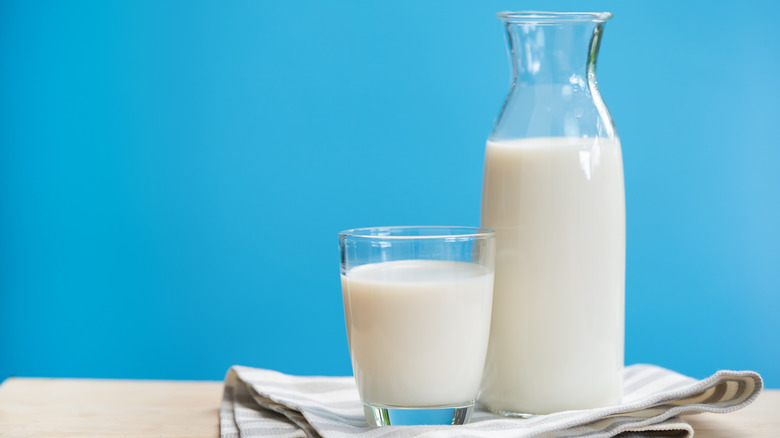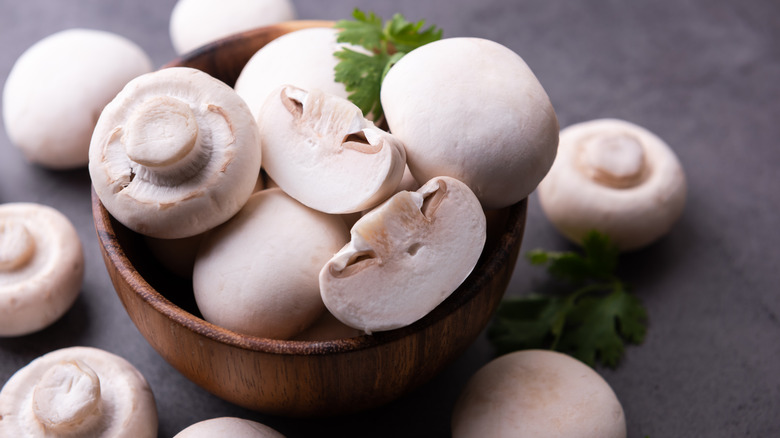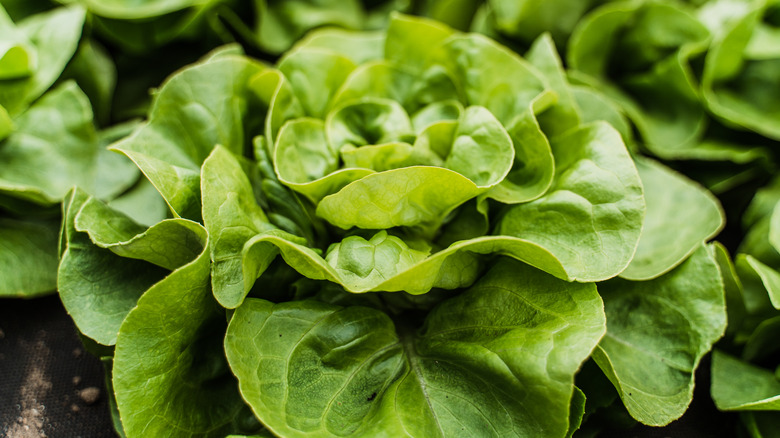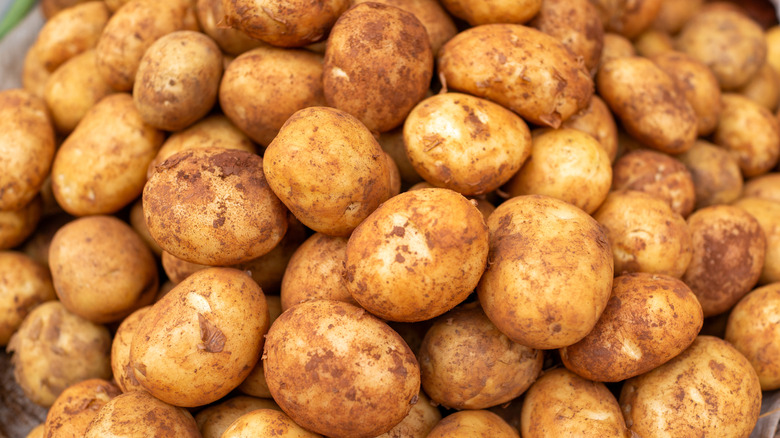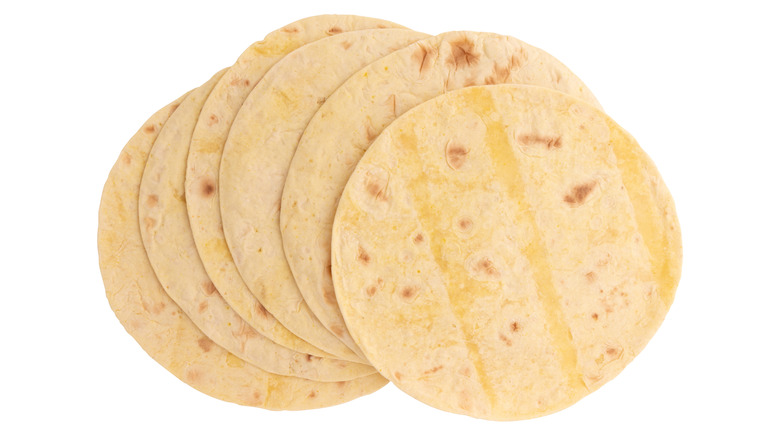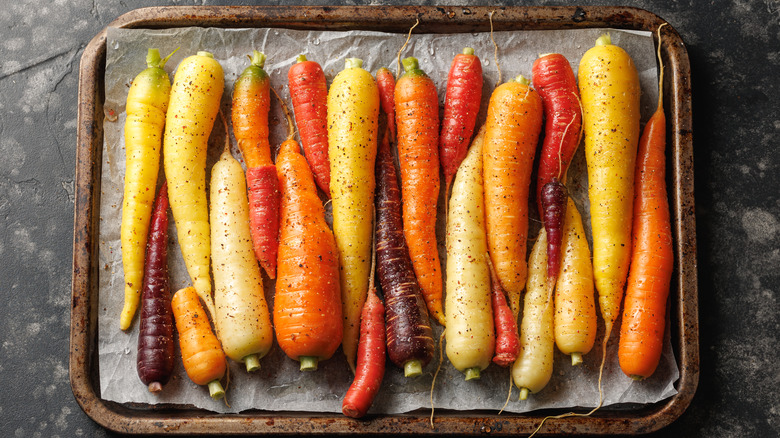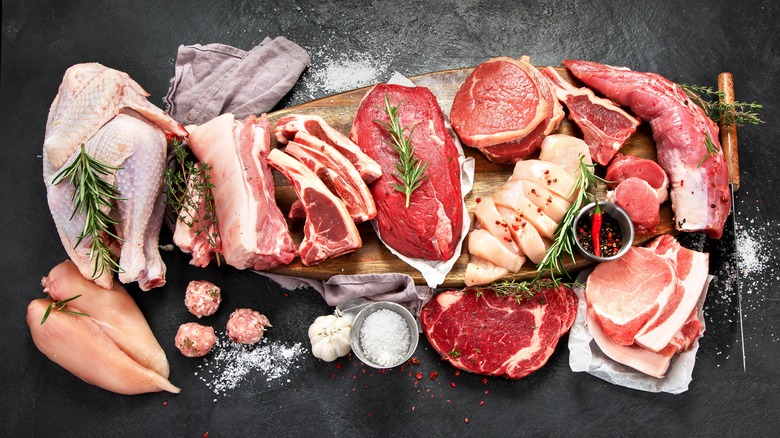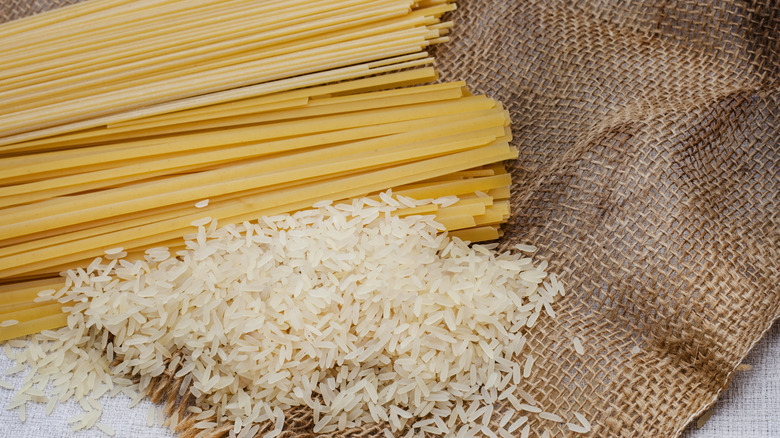10 Foods That Should Never Be Frozen
We may receive a commission on purchases made from links.
Let's just go ahead and set the scene: You're all ready to make your grandmother's fantastic Quiche Lorraine recipe, with all the ingredients you'll need on hand. You're a thoughtful and thrifty consumer who likes to get the most out of your food staples, and you have discovered the easiest way to do exactly that is to freeze them. You go to your icebox to get what you'll need: eggs, onion, and cheese. You remove them and place them on the counter to thaw.
Only, upon returning later, you notice that your eggs are cracked and leaking over your countertop. You attempt to cut into your onion and it implodes into a mushy mess, and your cheese becomes a crumbling disaster once you try to shred it. It turns out science — specifically thermodynamics – has ruined your food. The water in your ingredients has gone through a change due to it being frozen, and those changes have affected their physical state. And if your foods were allowed to be exposed to oxygen during the freezing process, that could lead to additional changes and possibly the proliferation of bacteria.
You can safely and effectively freeze almost any food with the help of a decent Cryovac system, which removes oxygen before freezing. Those can be expensive, though — it's much easier and more affordable to run down some of the most common foods that should never be frozen (with some obvious caveats). Let's get into it.
Raw eggs
Here's an easy one to start, as the aforementioned runny mess on your countertop ties in directly to thermodynamics. Eggs are mostly liquid, and when liquids freeze, they expand. This expansion causes the egg to crack, which leads to liquid egg seeping everywhere once the egg is defrosted. Raw eggs that have first been frozen and then later thawed may also change in terms of texture, becoming quite viscous and possibly lumpy.
The great filmmaker Alfred Hitchcock had a fear of eggs, and you may have a similar aversion due to their general sliminess or other factors. If you can't get past the perceived grossness long enough to crack an egg, perhaps you should just freeze it whole in the shell and then boil it. By doing so, you've accomplished a couple of things. First, you've managed to eliminate the ick factor of the mucky raw material inside without ever having to come in contact with it. Secondly, you've done the only thing you should do with a frozen egg.
Cheese
Simply put, freezing cheese can be dicey. There's not just water involved. Things become chemically more complicated due to the amount of salt, oil, and fat, which varies depending on the type of cheese, and how it reacts to the cold in different ways. The most vulnerable would be the more specialized, or soft, cheeses, such as Camembert and Roquefort. But even the sturdier stuff, like a trusty block of cheddar, will have gone through a shift in texture consistency once you attempt to work with it. Remember that cheese from the Quiche Lorraine.
It may be useful to keep in mind that the more processed a cheese is, the better suited it is for freezing. For example, that low-moisture mozzarella you've bought especially for an as-yet-unscheduled pizza night is going to hold up better frozen than that Humboldt Fog brought home from the farmers market cheesemonger. Processing includes prepping, so it will be fine if you're shredding the cheese beforehand with the thought of using it sooner than later for a specific dish.
Milk you plan on drinking
Milk you plan on using for cooking and baking purposes will have so much going on with the interaction of other ingredients that freezing is not a significant factor in how the milk will perform within your recipe dynamic. If you are planning on drinking the milk after it has been frozen, though, you may find doing so can put you in a rude mood (or moo-d), as the texture and flavor might become undesirable to the typical palate.
The big change will likely be in its taste, with the milk seeming less robust and sugary. There may also be an issue where the milk separates once thawed, depending on the amount of fat in it. While that flavor will fade out through the cooking process and the interaction with other ingredients, it would be wise to keep any milk you intend to drink directly, incorporate into a hot beverage, or splash on your morning cereal as fresh as possible.
Mushrooms
Mushrooms are delicate enough in texture and so full of water that they often can be altered irrevocably when frozen, and that will result in less desirable shroom and more undesirable mush. When they are thawed after freezing, they tend to be useful only as part of soups or other dishes where the mush is just fine as long as you're still getting that shroom flavor. In other words, forget topping a salad with them.
If you're looking for a better way to extend the fun times you can have with your fungi, forget freezing altogether and consider adding dried mushrooms to your pantry. Not only will they keep better and longer in a dehydrated state, but they can be easily revitalized once you add them to some boiling water and will present a stronger mushroom taste desirable for any recipe where you attempt to put the flavor pedal to the mushroom metal.
Lettuce
Similar to mushrooms, the water in lettuce forms into ice crystals that can damage the walls, which simply won't stand up in any respectable salad. With over 100 different types of lettuce, there's a lot to leaf through when getting better acquainted with its care as a food. For example, soft-leaf lettuce, such as romaine or red and green leaf, is definitely not a good idea unless you're thinking of incorporating them into a soup or casserole (don't laugh — you can in fact turn your salad into a tasty soup).
More firmly-stalked or long-leaved varieties, such as radicchio or an endive, have a better chance of holding up in the freezer, but, honestly, anyone other than a lettuce farmer with a healthy surplus crop probably doesn't need to take up brain space with that knowledge. Suffice it to say that you should freeze this entry on our list according to very specific types and for very specific reasons.
Raw potatoes
Raw potatoes can be vulnerable to changes in texture, again due to moisture, so the process of freezing and thawing can quickly turn your spuds into duds. Treat them like you would eggs that you also plan on freezing, and consider cooking them first. While this provides no guarantee to maintain absolute integrity for all complex culinary works incorporating cooked potato, a whole, precooked spud stands a pretty good chance to come out of whatever ice age you impose upon it.
Unlike mushrooms, dehydrating raw potatoes is not easy or convenient. If, to paraphrase the late great Ol' Dirty Bastard of Wu-Tang Clan, "Ooh baby, you like it raw," then for tater tots' sake, keep them away from other produce like bananas or onions, as keeping them in close proximity may not only encourage sprouting, but the ethylene gas emitted will have them shriveling up and aging fast.
Tortillas
Freezing tortillas is truly a matter of personal preference. Their shelf life may be increased dramatically by doing so, and it's easy to go into it thinking, "Hey, I'm going to be serving these warm anyway, so no big whoop." However, frozen tortillas can develop an undesirable, brittle quality if you don't store them properly in the freezer. If any oxygen comes in contact with them, freezer burn is going to be the wrong kind of char for your processed masa or flour.
If you are making homemade corn tortillas, make sure to keep them in short stacks of no more than 10. A couple more considerations include: (a) wrapping them in aluminum foil in addition to storing them in some manner of plastic wrapping that will render the storage airtight and (b) similar to the pre-cooking of certain items on this list, you should do any pre-cutting of tortillas you plan on using for chips in nachos or chilaquiles prior to freezing.
Raw carrots
Now this list is really cooking, as here we have yet another item that you can keep from becoming "under the weather" by precooking. Similar to cooking eggs ahead of time, blanching carrots first will keep them from losing their crispness through the freezing process. Freezing unblanched carrots can also affect their taste and color. You may lose out on two-ingredient, crispy carrot chips that serve as a delicious alternative to other snack chips, but that is a price that simply must be paid in cold currency.
Contrary to what you might think, blanching actually helps carrots keep their texture, although a quick ice bath afterward is recommended. Then it's a matter of cutting them up, sticking them on a flat tray of some kind, and popping them in the freezer. And with that, you have got yourself an a-peeling solution to any frozen carrot texture issues!
Previously thawed raw meat
While freezing raw meat is a perfectly acceptable way to preserve it until you are ready to cook, once it's been thawed, there are variables such as bacteria and changes in texture and flavor that make refreezing a no-no. Think about it: Once you have exposed your uncooked steak, pork chop, or chicken breast to a thaw in the open air, any bacteria present is given an opportunity to thrive and become enmeshed in the meat through refreezing.
The answer can be as simple as going ahead and cooking any leftover meat beyond what is required for the dish you started to cook. Refreezing cooked meat is a different matter — bacteria associated with raw meats are cooked off, and the texture of the meat has been determined predominantly by the cook. You would think precooked meat can limit your cooking choices, but imagine a delicious repurposed taco meat soup, a decadent leftover brisket mac and cheese, or all the genius ways to use leftover rotisserie chicken, like in nachos.
Cooked pasta and rice
Sometimes cooking alone is not enough to save food. Particularly with cooked rice and pasta, freezing can quickly turn a beloved carbonara or risotto into carbo-nada or ris-oh-no! Freezing done wrong will almost always have an adverse effect, and grains like rice and flour are unfortunately no different. There is a caveat, however — removing absolutely all oxygen from the food in an airtight environment. As such, a return to the discussion of a Cryovac system is warranted.
Don't confuse Cryovac with cryonics, because we aren't discussing freezing dead people. Rather, Cryovac technology is vacuum sealing, which is useful because food in a vacuum doesn't deteriorate as fast. In fancy food science terms, it creates an anaerobic environment. (No, that has nothing to do with your HIIT workout at the gym.) It simply means no oxygen allowed. Mold and bacteria need oxygen to survive, so using Cryovac technology for practically everything on this list is a worthwhile consideration. Although the top-of-the-line models can run you into the neighborhood of $200, more affordable versions can be found at as low as $40, such as this INKBIRD Compact Food Preservation System.
